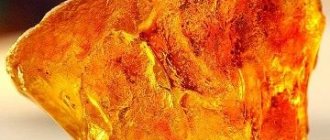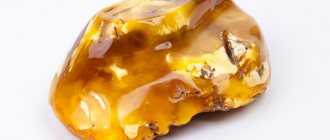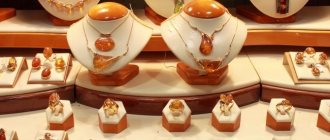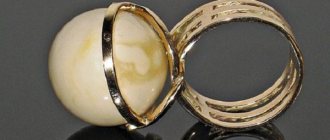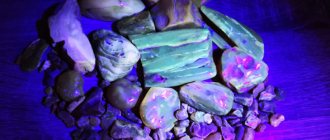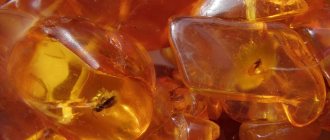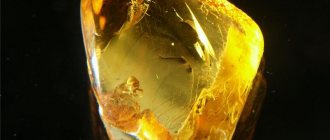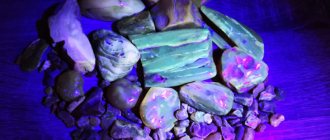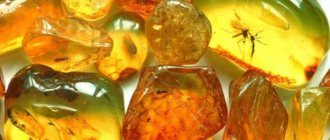Amber
- petrified fossil resin, hardened resin of the oldest coniferous trees of the Upper Cretaceous and Paleogene periods. It is used mainly for the manufacture of jewelry and haberdashery, costume jewelry; It is also used in small quantities in pharmaceuticals and perfumery, in the food, chemical and electronics industries.
- Structure
- Properties
- Morphology
- Origin
- Application
- Classification
- Physical properties
- Optical properties
- Crystallographic properties
See also:
Amber
– price and medicinal, magical properties
Physical properties and structure of diamond
Amber deposits
Even during the Iron Age, amber was mined on the territory of the Jutland Peninsula (present-day Denmark), but local deposits were exhausted, which stimulated the search for new deposits of the stone. Today, there are two main amber-bearing provinces in the world: Eurasian (Baltic-Dnieper, Carpathian, North Siberian, Far Eastern, Sicilian, Burmese amber) and American (North American and Mexican amber).
History of amber
— Advertising —
A beautiful and durable mineral amber has been used by man in the manufacture of jewelry and household items since ancient times. It was used to make both rich jewelry and practical items such as a cigarette case, ashtray, casket, casket and even a watch.
Among the Greeks, amber was known as "electron", after the star Electra (Pleiades family, Taurus Constellation), as they paid attention to its ability to become electrified. Residents of Ancient Rus' also called amber “ilektr” or “ilektron”.
The term "amber" (as in "entar") comes from the Lithuanian language ("gintaras"), and appeared in Old Russian only in the mid-16th century. It is believed that this term dates back to the oldest form of the verb “to protect”, and is due to the fact that amber has always been considered a powerful protective amulet.
The French call amber "ambre". The term was borrowed from the Arabs, who believed that it represented solidified dew that fell from the sky. A similar term later became widespread in Romano-Germanic languages. The Germans named amber “bernstein” from the word “brennenstein” (translated as “combustible stone”), for its ability to easily ignite and burn with a beautiful fragrant flame. This term became widespread among the Poles, transforming into “bursztyn”, and among Belarusians and Ukrainians into “burshtyn”.
Amber medicine
Modern medicine has split into two unequal camps. Official medicine, while still maintaining its leader status, continues to persist in rejecting ancient methods, declaring them pre-scientific, and therefore anti-scientific (although one does not follow from the other). There is also so-called alternative medicine - this extremely unfortunate term refers to everything that goes beyond the scope of official medicine: both archaic and ultra avant-garde. Traditional medicine, once considered traditional, has now become alternative. Its adherents often cannot provide a scientific basis for their recommendations, but they do not try very hard to do this, but simply refer to the experience of their ancestors - which is also not stupid and, mind you, is effective in practice.
According to many, including Dr. Klyuev , the future belongs to a symbiosis of scientific and so-called alternative medicine. Now, at their junction, a new science and practice is slowly and difficultly emerging, combining empirical experiments with modern methods of treatment. It is often called naturopathy - however, everyone interprets this word as God puts it on the soul. Literally it means “natural medicine”. As for what lies behind it, opinions differ. Some reduce naturopathy to rational nutrition, others identify it with sets of physical exercises, hardening-training, etc., while others give it a broader meaning - a set of techniques based on non-violent, natural, therapeutic agents that are harmless to the patient.
Modern amber therapist B.V. Klyuev, considering himself a naturopath, adheres to the third interpretation and belongs to those doctors (not yet particularly numerous) who, having a classical medical education, turn to “old-fashioned”, “pre-scientific” methods of healing. Why did you need to contact them at all? The answer can be different. It's not uncommon to hear references to fashion. But fashion almost never arises out of nowhere - it is certainly conditioned by at least something. For example, this reason: demand generates supply. But this is not the answer, since the fact that patients have lost faith in scientific medicine does not explain everything. Firstly, not all, but only a part of the patients believed, and secondly, to discredit science is as pointless as to discredit witchcraft. Both here and there there are professionals and laymen. On the other hand, if the effectiveness and harmlessness of a synthetic drug is clinically confirmed, there is no need to refuse it. The same applies to surgical intervention: many staunch supporters of traditional medicine do not accept it, but there are situations when it becomes the only way to save the patient’s life!
Probably, the birth of naturopathy in a broad sense is due to the fact that science - and not only medical science - has developed enough to harmoniously combine with “antediluvian” medicine. In toxicology there is such a concept - potentiated synergism of poisons. In the same way, pharmacologists talk about potentiated drug synergism - this is when several drugs, taken in carefully selected combinations and dosages, enhance each other’s effects. And there is also antagonism between drugs: one kills the effect of the other, negating its benefits.
Similar relationships may exist between medical schools. Ultimately, it all depends on the level of existing knowledge. Under some conditions, two contradictory medical doctrines objectively cannot find a common language, but can only, in the words of Chernyshevsky, “fight and swear”; under others, they cannot NOT find a common language. Modern scientific medicine, in my opinion, has grown today to at least lead to an understanding of some phenomena that were previously considered supernatural, miraculous and inexplicable. After all, the ancient healer knew for sure only that amber healed, but why, how it healed, and, most importantly, what kind of amber it was remained unclear.
Now the conditions have arisen for the antagonism of scientific and traditional medicine to be replaced by their “potentiated synergy.” This process has already begun, although it is still going slowly and with difficulty.
In relation to amber therapy, the mentioned synergism is expressed as follows. Amber and healing amber are two different things. Stones with healing properties have very little in common with those that many of us happen to find on Baltic beaches and dunes (and few of us on the White Sea). If you just collect pebbles, drill holes in them, make beads and wear them, it won’t help.
Physico-chemical characteristics of amber
Amber is an amorphous framework polymer that does not form crystals. It is not characterized by birefringence, dispersion and pleochroism. Luminescence is bluish-white or yellow-green. The stone is flammable and can catch fire even from the flame of a match. When rubbed, it becomes electrified. Can be polished well. In air it quickly oxidizes (“aging of amber”), changes its color and becomes brittle.
Types of amber
Amber samples are classified according to their degree of transparency into:
- transparent - stones of the highest quality, without voids;
- cloudy – translucent, cavity density 600/mm2;
- bastards – opaque, cavity density 2500/mm2;
- bone - opaque, ivory-colored, cavity density 900,000/mm2;
- foamy - opaque, similar to sea foam, cavities both small and large, frequent.
Magical properties of amber
Since ancient times, amber has been a symbol of happiness and health; it was used as a protective talisman and valued as a source of creative strength, self-confidence and optimism.
The mineral helps strengthen intuition, helps in the implementation of plans, gives good luck, joy and tranquility, and vigor. It is believed that pregnant women should wear amber to preserve the fetus and give birth easily. And nursing mothers who wear amber beads have children who grow up kind and cheerful.
Pieces of raw amber are placed next to the pillow to ward off evil spirits. And amber amulets protect the house from fire and lightning.
Amber is a symbol of spiritual connection. Its low grade samples are used to produce a pleasant smoke - incense. They used to fumigate newlyweds and newborns for happiness.
Amber - a stone of happiness and longevity
The amber stone has long been considered a symbol of health, longevity, happiness, good luck and beauty. In Rus', amber was considered a mandatory decoration for the bride on her wedding day. Pregnant girls were recommended to carry a sun stone with them so that it would protect her and the child from evil forces.
Some classics tell the story of one girl's longing for her lover. Having drunk an unknown enchanted drink, she turned into a poplar, but continued to cry now with amber tears.
The healing properties of amber
Since ancient times, it has been believed that amber can heal a person from any disease.
And now it continues to be actively used in medicine. Amber relieves headaches and toothaches, treats sore throats, softens the effects of magnetic storms, and improves heart function. Amber has a positive effect on the state of blood, lymph, tissue fluid, treats joint diseases, varicose veins. Modern medicine indicates that the mineral prevents the process of hemolysis (destruction of red blood cells).
The properties of amber are used for mastopathy, cysts, fibroids, fatty tissues, tumors of various types and origins.
Due to their iodine content, amber beads are recommended for the treatment and prevention of thyroid disorders. Microelements and salts of succinic acid activate metabolism, the functioning of the digestive system, and have an anti-inflammatory and bactericidal effect.
Amber tincture is used for colds, throat and respiratory diseases. Amber plates are rubbed on the temples for headaches; when teething, children are given pieces of amber to chew on.
Login to the site
A selection of facts about such an amazing material as amber. ———————————————
1. Amber is a gem, but not a precious stone. This is not a mineral, but the fossilized resin of some ancient trees that took root 38-120 million years ago. Its appearance was facilitated by a critical change in the Earth's vegetation cover. Due to the change in climate from dry and hot to temperate, many new plants appeared, but other types of vegetation disappeared, including cycads, sago, ferns...
2. The world's largest amber repositories are located in the Baltic region. According to a report by the Royal Society of London for the Advancement of Natural Knowledge, more than 105 tons of Baltic amber were mined in northern Europe, in areas where forests were located in the Paleogene period.
3. The world's largest amber is in the Amber Museum in Copenhagen. When it was found, the amber weighed about 80 kg. A piece of amber, believed to be 25 million years old, was found in 2014 by miners from West Sumatra. Now its weight is 47.5 kg, and its dimensions are 57.5 x 62 x 37 cm. In second place is “Burmese Amber”, which weighs 15 kg 250 g. You can find this amber in the Natural History Museum in London. The second place in the list of the largest amber is occupied by a piece of amber weighing 12 kg, which was found in the second half of the 19th century in Prussia. Other large pieces of fossilized resin were also found at the same location. Among them are amber weighing 9.7 kg and 7 kg. At the beginning of the 19th century, near the city of Gusev, a piece of amber weighing 6 kg 750 g was found. Its length is 37 cm, width - 21 cm and thickness - 14 cm. And yet it is worth saying that such large amber is extremely rare - in all history, less than 10 specimens weighing more than 5 kg were found.
4. There are more than 300 colors in which amber is painted. The color of amber is not always yellow, red or orange. This gem can be white, green and blue. Blue amber can only be found in three countries on our planet - Mexico, Nicaragua and the Dominican Republic. It will be interesting to note the fact that tropical amber, colored blue, can phosphorescent, which means jewelry made from it becomes even more original and unusual. It is also worth noting that there are samples of several colors. For example, the so-called “sun stone”, found in Central America, has about 30 shades. This amber originated from the resin of the carob tree (while Baltic amber was formed from the resin of coniferous trees). But not everyone is able to process blue amber, since it is the hardest amber of all.
5. For amber to form, it takes millions of years and certain conditions for the resin to be buried in forest soils. Most tree resin is chemically unstable and will rot over time instead of hardening. To make amber, the resin must be underground under certain conditions - the soil must be dry and oxygenated, and in wetlands where there is no oxygen, tree resin remains fragile. Also, one of the stages of amber formation includes erosion, transfer and sedimentation of resins into a water basin.
6. The word "electricity" comes from the Greek word meaning "amber". According to the Swedish Amber Museum, over 2,500 years ago, Greek philosopher Thales of Miletus discovered that if you rubbed an amber stick on wool, it became charged with static electricity, creating sparks, after which it attracted feathers and head hair (if you zoomed in). This force is called "electricity", from the Greek "electron", which means "amber".
7. Many animals, and even a dinosaur “feather” were stuck in amber. Insects can be seen inside the amber shards. Since amber resin has the property of mummifying, all the “victims” preserved in the resin millions of years ago were preserved in their original form. Also inside amber you can find frogs, lizards, bird feathers, snake skin, mammal bones, and many plants. It is worth noting that all animals and plants stuck in amber are called inclusions. Such amber is much more expensive than ordinary amber - its cost can reach up to $20,000. The most interesting amber is the one that preserves the feather of a theropod (a predatory dinosaur).
8. Among the most expensive amber, three can be distinguished: one in which a whole frog was preserved, one with a 7-centimeter chameleon, and one with a 10-centimeter lizard. Each one costs several tens of thousands of dollars. Only 30 specimens of amber with lizards and 50 specimens of amber with butterflies have been found throughout the world.
9. Scientists tried to extract the DNA of animals stuck in amber. Unlike the scientists in the movie Jurassic Park, real scientists have not yet been able to extract functional DNA from insects imprisoned in amber. DNA has a half-life of 521 years. This means that after a given period of time, half of the bonds between the chains of nucleotides in DNA will be destroyed, after another 521 years, half of the remaining bonds will disappear, and so on.
10. Many extinct species were discovered thanks to amber. Thanks to its ability to mummify insects and animals, paleontologists have been able to recreate life on Earth in its early stages. They also found more than 1,000 extinct insect species.
11. Baltic amber was found in Egyptian tombs. The ancient Egyptians were very fond of amber. Plenty of evidence indicates that Egyptian tombs dating back to 3,200 BC contained pieces of amber. Some believe that amber was used as a symbol of the tears of the god Ra. It is believed that this amber was formed on the Baltic coast, 2,400 km from the tombs. Amber also adorned the crown of the Egyptian pharaoh Tutankhamun.
12. People have been using amber to create jewelry as far back as 11,000 BC. Several thousand years ago, people could already process amber and make jewelry from it. This is evidenced by archaeological excavations in England.
13. The oldest amber is 320 million years old. Most of the amber on the planet is at least 90 million years old, but there are some incredibly old examples. In 2009, in a coal mine in Illinois, scientists found a piece of amber that was 320 million years old. In structure, it was no different from the “younger” amber. This discovery made a significant contribution to the history of plant evolution. Scientists have learned that amber appeared much earlier than they thought. The ancient animals found in amber represented the Triassic period, which began 250 million years ago and ended 200 million years ago. Despite being around 230 million years old, they are very similar to modern gall mites.
14. There are several types of amber. The most famous type of amber is succinite. Waxy yellow amber is gedanite. Opaque brown amber - glossite. Opaque amber of a dark brown hue - bockerite. The most fragile black amber is stantienite.
15. Amber mined in the mines of Mexico, Nicaragua and the Dominican Republic is of particular value because inclusions (insects, plants, fish or parts of mammals “stuck” in the amber) are much more common in it.
16. Cherry amber was especially popular in China and Japan, especially among members of the imperial family. And in Ancient Rome, transparent amber of a reddish hue was valued. In eastern countries, transparent yellow amber with a green tint, as well as cloud amber, which has a milky white tint, were very popular.
17. A fragment of a “sun stone” was found in Haiti, inside of which an ancient spider was preserved. According to scientists who studied this amber for 2 years, the 4-centimeter insect found lived in what is now Haiti 120 million years ago. Surprisingly, the age of the amber was determined thanks to the blood of a spider.
18. To distinguish real amber from a fake, you just need to immerse the object in salt water. Natural amber, immersed in a glass of water and 2-3 tbsp. spoons of salt, it will float, and the fake will sink to the bottom.
19. In places where amber is mined, you can purchase a large multi-colored unprocessed sample for $250. But in order to see any prehistoric detail inside the amber, it will have to be polished.
source
Branches of amber application
Amber has been used since ancient times as a jewelry and ornamental stone, but when processing it, the primary dimensions and weight of the stone were significantly reduced, which led to an increase in the cost of finished products.
Now special technologies have been created that make it possible to give amber the desired colors and texture: lightening, heating, heating, chemical treatment, polishing, cutting, carving. Low quality amber varieties are valuable chemical raw materials in the production of succinic acids, oils and rosins, which are used by the perfume, pharmaceutical and paint industries. Succinic acid is a food additive E363. The surfaces of insulators are coated with amber varnish to increase the surface resistance. It was also used to preserve wood - the bottoms of ships, furniture, and the soundboards of musical instruments.
The legend of the son of the Sun - where did the golden gem come from?
Not only Asians loved and revered the amber stone; the ancient Greeks also attributed magical properties to it. Thus, the poet and researcher Ovid in his work “Metamorphoses” gives the following legend about this mineral.
Helios, the god of the Sun, had an only son - the brave and curious Phaeton. The young man was extremely fond of watching his father rise into the heavens on his fiery chariot drawn by golden-maned horses. He would also like to ride it, but Helios forbade him, saying that he would not restrain the unruly animals. And then one day Phaeton secretly entered the stable, harnessed the horses and rose into the sky. The running of the animals became faster and faster, they rose higher and higher into the high sky, Phaeton’s hands were burned by the radiance of the luminary - and he released the reins.
Feeling freedom, the horses began to rush from earth to sky. When they rose too high, the earth's firmament turned to stone from the cold - and when they descended lower, terrible fires broke out on it, killing all living things in their path. Even the deities suffered - Atlas, who held the whole world, could no longer endure the madness of the raging luminary.
And then Gaia turned to Zeus with a desperate request to stop the bacchanalia. The Thunderer threw a golden lightning arrow that smashed the chariot. And the beautiful Phaeton, engulfed in unquenchable fire, fell from heaven like a star. He was received by the waters of Eris, a cold river at the very edge of the Earth. There wasn't even a grave left over which his mother and sisters could cry.
To ease their grief, the gods turned women into trees. Now they were doomed to forever stand above the transparent waters, dropping golden tears into them, which, when frozen, turned into a shimmering stone.
How to distinguish real amber from a fake
First of all, it is necessary to distinguish imitations and fakes from processed natural amber.
Pressed amber is made from natural raw materials, while imitations contain either a minimal amount or no mineral at all. Today, fake amber made from epoxy resins is very common, to which they even add “fossil” insects. In addition, modern plastics are also capable of reliably imitating natural amber.
The mineral burnite is sold on the market - artificial “fused” amber from various polyester resins, imitating the structure of hot amber and obtained using “micro-explosions” to create a fractured structure.
Counterfeits are distinguished visually by resin drips that form a “capillary network.” They also lose their color and quality much faster, unlike natural amber.
Interesting facts about the yellow mineral
Let's look at some interesting information about this stone:
- Amber is a mineral that was revered by many peoples as a stone of power. For example, Pharaoh Tutankhamun’s crown was decorated with this mineral.
- In Ancient Greece, this gem was considered the stone of the sun.
- Amber often contains inclusions called “inclusions.” These are arthropod insects. They died in a quickly solidifying mass. Thanks to this, it was possible to preserve the smallest details well.
- The ancient Romans had their own version of how the amber stone was formed. These people called the mineral "lincurium". Translated, the name means “lynx urine.” According to legend, amber is believed to be a beautiful stone that was formed from the petrified urine of a representative of the (mountain) cat family.
How to care for amber
Amber products are handled with care, stored separately from other stones and exposed to direct sunlight as little as possible in order to preserve the color and properties of the stone for as long as possible. To clean amber, use a mild soap solution and a soft brush, after which the stone is washed with cool running water and wiped dry.
Interesting facts about amber
- So-called “amber storms” occur periodically, when the seas wash large quantities of amber ashore. According to scientists, the waters of the Baltic Sea annually wash out 36-38 tons of amber from the bottom and wash ashore. Over the past three thousand years, this amounts to about 125 million kilograms of the mineral.
- The ancient Egyptians used amber in the mummification of pharaohs. This is due to the property of the mineral to preserve animal and plant flesh for a long time. Amber prevents the processes of hemolysis (destruction of red blood cells) and blood clotting. Now, for the same reason, medical utensils, instruments and devices necessary for blood transfusion and preservation are made from it.

